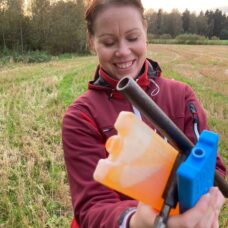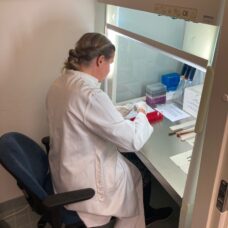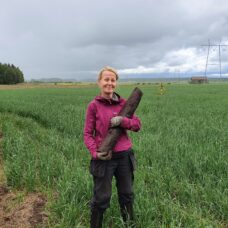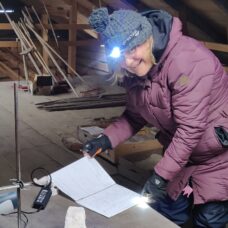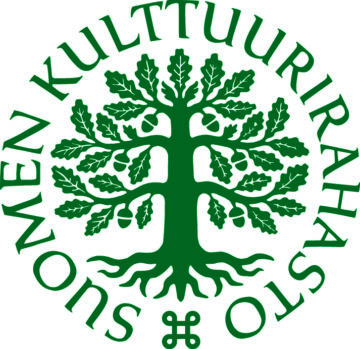Seeing the Unseen with aDNA
Combined studies of aDNA and sedaDNA obtained from plants, animal bones and invertebrates can significantly add our knowledge about the past and help us seeing the unseen.
The objective of this study is to compare archaeological data with historical (1800-1950s) and contemporary data on varieties and breeds of apples, hops, and cattle. Additionally, the study will investigate the usefulness of aDNA barcode identification methods for species in archaeological research. The study will use genetic methods to investigate past natural biodiversity, including genetic variation at the population and species levels, as well as differences in the composition of plant and animal communities.
The samples were collected from two significant archaeological sites, Humppila Järvensuo 1 and Turku Cathedral School. The first site dates back to 6000-2000 calBC, while the second site contains material from the Middle Ages (1200-1500 AD). The organic material at both sites has been well-preserved due to the humid soil conditions.
What is aDNA Research?
Ancient DNA (aDNA) research uses DNA isolated from ancient remains as a source of information. This method has revolutionised bioarchaeological research in recent years. DNA is present in the cells in nucleus and mitochondria of living eucaryotes such as animals, fungi, and plants, the latter of which contain DNA also in chloroplasts. DNA can persist for centuries or even millenia in suitable conditions. All organisms, living or dead, disperse cells into their environment. This is known as environmental DNA (eDNA). Archaeological material preserving environmental ancient DNA (eaDNA) in sediment layers of soils and water bodies is called sedaDNA.
DNA metabarcoding is a special method allowing species identification from individual fossil fragments as well sediment samples. This method can be used to identify individual species and past faunal and floral communities. When aDNA is studied thoroughly it enables also the examination of animal and plant races.
In this project, the aDNA methods will be utilized to provide additional information about two archaeological sites: the Stone Age settlement in Humppila and the medieval urban quarter in the Turku Cathedral School.
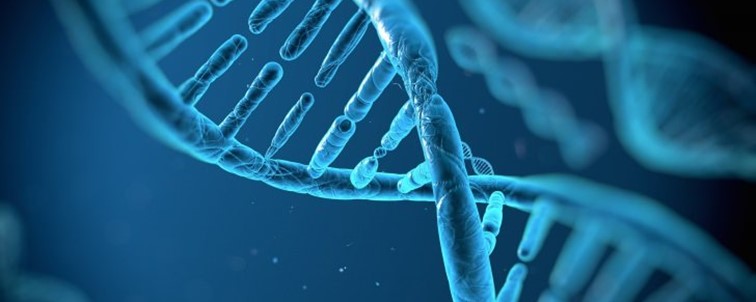
History of Apple and Hops
Plant cultivars in the past can be studied using microsatellite markers in aDNA. The study will use hop and apple seeds from archaeological sites, whose DNA will be compared with botanical collection samples from Turku Herbarium and genetic data from hop and apple varieties collected by the Natural Resources Institute of Finland. The project will provide information on the origin of these plant varieties and their routes of introduction and trade. Photos: Mia Lempiäinen-Avci.
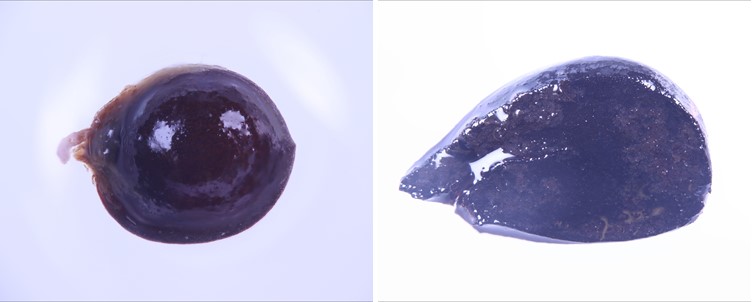
Origin of Cattle
Cattle played a crucial role in agriculture during the Medieval period. They were not only used for milk production but also for fertilizing and plowing fields, which provided the main source of food, namely grain. In Finland during the Medieval period, cattle were not bred for specific breeds, resulting in a diverse range of backgrounds for these animals. Some of these cattle have been raised in the Finnish region since prehistoric times, while others have arrived more recently with humans. However, all of them share the ability to adapt to local conditions and breeding methods. Resilient individuals have thrived over time, and even today, these characteristics persist in traditional Finnish cattle breeds. They excel in forest pastures and are efficient users of fodder. Photos: Auli Bläuer.
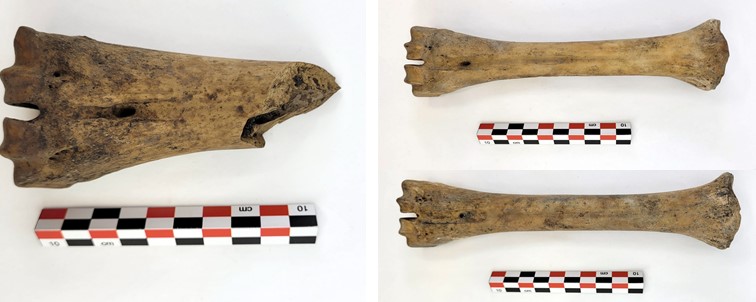
Investigation of Invertebrates
Around 85% of the world’s biodiversity consists of invertebrates, particularly insects. Finland is home to over 28,000 species of arthropods, including beetles, ants, sting beetles, and mites. Although the hard outer shells of these groups can be preserved in the archaeological record, little research has been conducted on them in Finland. The most common arthropod fossil remains are the hard parts of organisms, such as legs, jaws, larval skins, and shells. These microfossils provide information about the species and conditions that lived in the area. Therefore, they also offer insights into human history, such as hygiene, nutrition, and material usage. Photos: Riikka Elo.

Sampling seda-DNA
Sampling at the Järvensuo I site involved removing the current cultivation layer and taking two sample cores up to a depth of 2.9 meters in 50 cm pieces. We made sure to handle the samples with care and placed them in sterilized plastic half-tubes, keeping them cold to ensure their quality. To prevent contamination, we thoroughly cleaned the peat sampler with water and bleach between every drill. Photos: Tanja Ratilainen
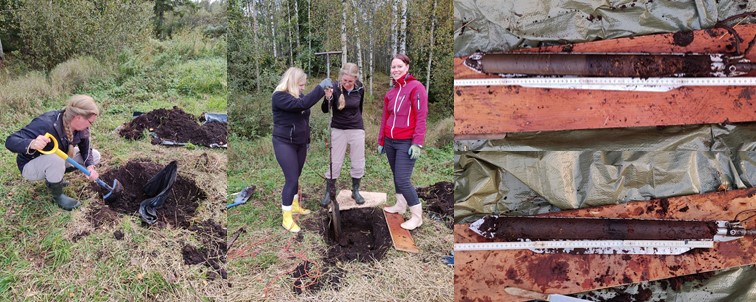
Archaeological Sites
HUMPPILA, JÄRVENSUO 1
In the 1980s, during the drainage and archaeological trial excavation of the peat bog on the southern shore of Lake Rautajärvi, Stone Age artefacts were found, indicating that the area had been inhabited more than 4,000 years ago. The finds also included well preserved wood and bark artefacts, which are extremely rare in Finland.
The return to Järvensuo 1 was made possible 35 years later, when the Academy of Finland funded a postdoctoral project by Satu Koivisto at the University of Turku (2019-2022). New excavations by the project revealed well-preserved organic materials from the Stone Age, such as fragments of fishing gear, wooden figurines, tools and post structures.

Figure 1. (left) An overgrown and later drained Lake Rautajärvi and its archaeological sites. Järvensuo 1 is marked with a red star (data: Finnish Heritage Agency and National Land Survey, photo: S. Koivisto); (right) two wooden paddles and a wooden spoon with a bear’s head carved into the handle found at Järvensuo 1 (photos: Finnish Heritage Agency and S. Koivisto). The project’s latest publication can be read here: https://doi.org/10.15184/aqy.2023.180
TURKU, CATHEDRAL SCHOOL
Archaeological excavations were carried out between 2014 and 2018 at the Swedish Cathedral School Gymnasium in Turku, as part of the school’s renovation works. The Museum Centre of Turku excavated the main building, the wing along Luostarin Välikatu Street, and the school yard during 2014-2015. New information was gathered about the earliest settlement phase in the medieval city area up until the great fire of 1827. Interestingly, a late medieval latrine was discovered during the investigation.
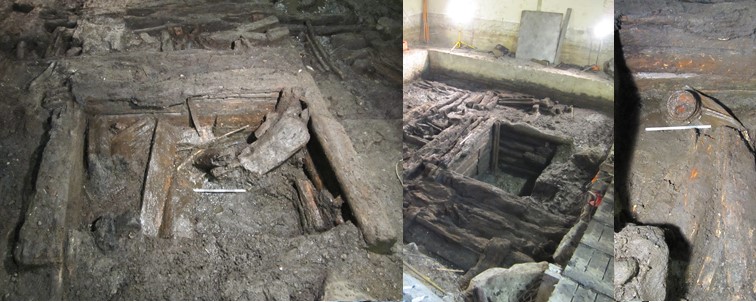
(Left) The upper part of the latrine contained wooden building waste. (Middle) Partially emptied latrine and the surrounding building remains. (Right) A stave vessel, possibly a chamber pot, was found in situ and contained a large variety of plant remains. Photos: MCT / Elina Saloranta. The contents of the latrine were selected for further examination. The results can be found at: https://journal.fi/fennoscandiaarchaeologica/article/view/126597/76415
Read more about Järvensuo 1:
Koivisto, S. 2023. Estuary and lacustrine fishing with stationary wooden structures in Neolithic Finland: Evidence from waterlogged sites. In: D. Groß & M. Rothstein (eds.) Changing Identity in a Changing World. Current Studies on the Stone Age in Northern Europe around 4000 calBCE, 53–62. https://www.sidestone.com/books/changing-identity-in-a-changing-world
Koivisto & Lahelma 2021. Between earth and water: A wooden snake figurine from the Neolithic site of Järvensuo 1. Antiquity 95(382): E19. https://doi.org/10.15184/aqy.2021.79
Koivisto, S. 2021. Järvensuo revival: Reinvestigation of the Neolithic wetland site of Järvensuo 1, south-west Finland. Fennoscandia archaeologica 38, 5–28. https://journal.fi/fennoscandiaarchaeologica/article/download/126590/76408
Lucquin et al. 2023. The impact of farming on prehistoric culinary practices throughout Northern Europe. PNAS, 120(43), e2310138120. https://doi.org/10.1073/pnas.231013812
Read more about Cathedral School:
Bläuer, A., Hukantaival, S., Saarinen, R., Hirvilammi, M. ja Ratilainen, T. 2020. “Cattle phalanx gaming pieces from Turku, Finland. Lund Archaeological Review 24–25: 7–25.
Ratilainen, T., Harjula, J., Immonen, V., Saloranta, E. 2016. The Medieval Town of Turku: Its Roots, Founding and Development till the 14th Century, in Lübecker Kolloquium zur Stadtarchäologie im Hanseraum X: Vorbesiedlung, Gründung und Entwicklung, Lübeck, pages 559–578.
Who We Are
Bläuer, Auli, Docent, Zoo-archaeologist, Department of Archaeology, University of Turku
Elo, Riikka, PhD, Biologist, Biodiversity Unit, University of Turku
Huttunen, Sanna (PI), Docent, Biologist, Biodiversity Unit, University of Turku
Koivisto, Satu, Docent, Archaeologist, Department of Archaeology, University of Turku and Postdoctoral researcher, Museum Lolland-Falster, Denmark.
Lempiäinen-Avci, Mia, PhD, Archaeobotanist, Biodiversity Unit, University of Turku
Ratilainen, Tanja, PhD, Archaeologist, Department of Archaeology, University of Turku
Read More
ABOUT JÄRVENSUO 1:
Aalto, M. 1983. Humppilan Järvensuon neoliittisen asuinpaikan kasvimakrofossiileista. Karhunhammas 7, 88-95.
Aalto, M., Siiriäinen, A. & Vuorela, I. 1985. Humppila Järvensuo – A preinvestigation for an archaeological and palaeobotanical project in SW Finland. Iskos 5, 165-77.
Edgren, T. 1984. En paddelåra från stenåldern. Festskrift tillägnad Matts Dreijer på hans 80-årsdag 31.01.1981, 83-92. Ålands Folkminnesförbund. Bygdeserie nr 5.
Hannunniemi, J. 2022. Ihmistoiminnan ja luonnonolojen kehitys
Humppilan Rautajärvellä. Pro gradu, Määperägeologia, Turun yliopisto. https://www.utupub.fi/bitstream/handle/10024/173015/Hannuniemi_progradu.pdf
Pohjakallio, L. 2005. Uusia kivikautisia löytöjä Humppilan Järvensuolta. Lounais-Hämeen Kotiseutu- ja Museoyhdistyksen Vuosikirja 74, 7-19.
Siiriäinen, A. 1983. Humppilan Järvensuon kivikautinen löytöpaikka. Karhunhammas 7, 79-87.
Siiriäinen, A. 1987. Excavations at Järvensuo. NewsWarp 2, 11-2.
Vuorela, I. 2002. Siitepölyanalyysillä lisävalaistusta Humppilan Järvensuon esihistoriaan. Lounais-Hämeen Kotiseutu- ja Museoyhdistyksen Vuosikirja 71, 7-21.
ABOUT CATHEDRAL SCHOOL QUARTER:
Bläuer, A., Hukantaival, S., Saarinen, R., Hirvilammi, M., & Ratilainen, T. 2021. Pelataanko babkaa?: Naudanluisia pelinappuloita keskiaikaisesta Turusta. Pelitutkimuksen vuosikirja 74. https://pelitutkimus.journal.fi/article/view/107854
Pihlman, A., Saloranta, E., Krappala, K., & Ratilainen, T. 2021. Turun kaupunkia vanhempi asutus ja kaupungin synty: Tulkinta varhaisen keramiikka-aineiston ja luonnontieteelisten ajoitustulosten perusteella. SKAS 2, 2-37.
Saloranta, E. 2019. Aurajoen rantojen rakentaminen kaupungin vanhalla ydinalueella ennen nykyisiä laitureita. In: Ratilainen, T. & Mustonen, R. (eds). Pitkin poikin Aurajokea: Arkeologisia tutkimuksia. Turun Museokeskus, 96–119: pitkin_poikin_e_kirja.pdf (turku.fi)
PROJECT NEWS
PUBLIC LECTURES on the sites and the results of the project will be held at the Turku Main Library starting from the 19th of September, 2024. Your can find the program here.
SPRING 2023: Project started! https://skr.fi/ajankohtaista/muinaisista-dna-naytteista-evaita-tulevaisuuteen
IN COLLABORATION WITH

